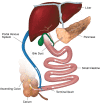Functional, Diagnostic and Therapeutic Aspects of Bile
- PMID: 35898963
- PMCID: PMC9309561
- DOI: 10.2147/CEG.S360563
Functional, Diagnostic and Therapeutic Aspects of Bile
Abstract
Bile is a unique body fluid synthesized in our liver. Enterohepatic circulation preserves bile in our body through its efficient synthesis, transport, absorption, and reuptake. Bile is the main excretory route for bile salts, bilirubin, and potentially harmful exogenous lipophilic substances. The primary way of eliminating cholesterol is bile. Although bile has many organic and inorganic contents, bile acid is the most physiologically active component. Bile acids have a multitude of critical physiologic functions in our body. These include emulsification of dietary fat, absorption of fat and fat-soluble vitamins, maintaining glucose, lipid, and energy homeostasis, sustenance of intestinal epithelial integrity and epithelial cell proliferation, reducing inflammation in the intestine, and prevention of enteric infection due to its antimicrobial properties. But bile acids can be harmful in certain altered conditions like cholecystectomy, terminal ileal disease or resection, cholestasis, duodenogastric bile reflux, duodenogastroesophageal bile reflux, and bile acid diarrhea. Bile acids can have malignant potentials as well. There are also important diagnostic and therapeutic roles of bile acid and bile acid modulation.
Keywords: bile; bile acid diarrhea; cholestasis; diagnostic and therapeutic roles of bile acids; function of bile acids.
© 2022 Ahmed.
Conflict of interest statement
The author reports no conflicts of interest in this work.
Figures
References
-
- Boyer JL. Bile Formation and Cholestasis. In: Schiff ER, Sorrell MF, Maddrey WC, editors. Schiff’s Diseases of the Liver. Philadelphia: Lippincott, Williams & Wilkins; 2002:135–165.
-
- Chen I, Cassaro S. Physiology, bile acids. In: StatPearls. Treasure Island (FL): StatPearls Publishing; 2021. PMID: 31747172. - PubMed
LinkOut - more resources
Full Text Sources




